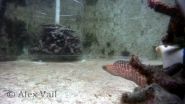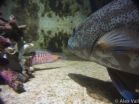(Press-News.org) VIDEO:
Coral trout are choosey about moray collaborators.
Click here for more information.
Coral trout not only work with moray eels to improve their chances of a meal, but they can also be choosy when it comes to picking the best moray partner. The findings reported in the Cell Press journal Current Biology on September 8 show that such sophisticated collaborative abilities are not limited to apes and humans.
The fish's behavior is remarkable in other ways too, the researchers say.
"The trout's collaboration appears to be relatively special, as it uses gestures to coordinate its hunts with partners of different species, such as morays, napoleon wrasse, and octopus," says Alexander Vail of the University of Cambridge.
Those other species are of more use to trout as hunting partners than members of its own species because the other species flush prey out of reef crevices in a way that the fish themselves can't, Vail explains. Their relationship to morays may be considered as social tool use: fish can't pick up a stick to pry something out of a crevice, but they can use intentional communication to manipulate the behavior of a suitable other species to achieve the same end-goal.
Chimpanzees are known to work with other chimpanzees to hunt in the wild, with individuals taking on different roles, such as chasers or blockers. Earlier studies have shown that chimpanzees also make good choices when it comes to selecting the best partner among their peers. Those collaborative skills have been interpreted as evidence for advanced cognitive processes in our closest primate relative, potentially representing the evolutionary origins of our complex human collaboration.
But Vail and his colleagues wondered whether those collaborative abilities might also be found in other, more distantly related species. They found the best candidate in a rather surprising place: among a genus of fishes known as Plectropomus. In fact, studies have shown that roving coral grouper fish will team up with moray eels, too. More recently, Vail found that coral trout also hunt collaboratively with moray eels on the Great Barrier Reef.
To examine the collaborative tendencies of the fish in greater detail, the researchers brought some of those fish back to the lab to test their interactions with moray eel decoys, one "good" and one "bad." The "good" moray would come to the coral trout's aid when signalled, whereas the "bad" one would swim in the opposite direction. In fact, some morays in nature are more helpful to trout than others.
By watching these interactions, the researchers found that trout were similarly proficient to chimpanzees at determining when to collaborate. The researchers' observations also showed that coral trout were quick to learn which moray eel model was the better collaborator.
As stunning as they are, the findings in fish may not prove as unique as they seem.
"Our study shows that these collaborative skills are not confined to apes and raises the possibility that they may be found in a number of other animal species for which they are ecologically relevant," Vail says.
INFORMATION:
Current Biology, Vail et al.: "Fish choose appropriately when and with whom to collaborate"
Coral trout pick their collaborators carefully
2014-09-08
ELSE PRESS RELEASES FROM THIS DATE:
Fish as good as chimpanzees at choosing the best partner for a task
2014-09-08
Coral trout are fast when chasing prey above the reefs of their habitat, but can't pursue their quarry if it buries itself into a hard-to-reach reef crevice.
When this happens, the trout will team up with a snake-like moray eel to flush out the unfortunate fish in a remarkable piece of interspecies collaboration: either the eel takes the prey in the reef, or scares it back into the open so the trout can pounce.
Coral trout - along with close relative the roving coral grouper - will use gestures and signals to flag the location of prey to an eel, including head shakes ...
Hog workers carry drug-resistant bacteria even after they leave the farm
2014-09-08
A new study suggests that nearly half of workers who care for animals in large industrial hog farming operations may be carrying home livestock-associated bacteria in their noses, and that this potentially harmful bacteria remains with them up to four days after exposure.
Researchers had believed that livestock-associated bacteria would clear from the noses of hog workers quickly – within 24 hours. But this small study of hog workers in North Carolina, reported online Sept. 8 in the journal Occupational and Environmental Medicine, suggests it can stick around longer. ...
Popular cancer drug target implicated in cardiovascular defects
2014-09-08
September 8, 2014 CHAPEL HILL – UNC School of Medicine researchers have discovered an unlikely relationship between CXCR7 – a protein implicated in tumor growth and metastasis – and adrenomedullin – a hormone involved in cardiovascular health. Deleting CXCR7 allows adrenomedullin to run rampant, triggering the development of an enlarged heart and the overgrowth of the lymphatic vessels that traffic immune cells and fluids throughout the body.
The study, published September 8 in the journal Developmental Cell, reveals that CXCR7 binds to the ligand adrenomedullin. The ...
UNC researchers find new genetic target for a different kind of cancer drug
2014-09-08
CHAPEL HILL, NC – Researchers from the UNC School of Medicine have discovered that the protein RBM4, a molecule crucial to the process of gene splicing, is drastically decreased in multiple forms of human cancer, including lung and breast cancers. The finding, published today in the journal Cancer Cell, offers a new route toward therapies that can thwart the altered genetic pathways that allow cancer cells to proliferate and spread.
"Historically, scientists haven't targeted the proteins in cancer cells that are involved in gene splicing," said Zefeng Wang, PhD, associate ...
Scientists apply biomedical technique to reveal changes in body of the ocean
2014-09-08
For decades, doctors have developed methods to diagnose how different types of cells and systems in the body are functioning. Now scientists have adapted an emerging biomedical technique to study the vast body of the ocean.
In a paper published this week in the journal Science, scientists demonstrate that they can identify and measure proteins in the ocean, revealing how single-celled marine organisms and ocean ecosystems operate.
The National Science Foundation (NSF) and the Gordon and Betty Moore Foundation funded the research.
"Proteins are the molecules that catalyze ...
Faces are more likely to seem alive when we want to feel connected
2014-09-08
Feeling socially disconnected may lead us to lower our threshold for determining that another being is animate or alive, according to new research published in Psychological Science, a journal of the Association for Psychological Science.
"This increased sensitivity to animacy suggests that people are casting a wide net when looking for people they can possibly relate to — which may ultimately help them maximize opportunities to renew social connections," explains psychological scientist and lead researcher Katherine Powers of Dartmouth College.
These findings enhance ...
Bone cancer surgical team sees success in new application of surgical aid
2014-09-08
(9/8/14, Lebanon, NH) —An ortho-oncology team at Dartmouth-Hitchcock Norris Cotton Cancer Center successfully adapted a shoulder surgical aid (the Spider Limb Positioner) to conduct a left hip disarticulation on a melanoma patient as described in a case report published online in Medical Devices.
The Spider Limb Positioner is a pneumatic arm with three fully articulating joints that can be infinitely adjusted in relation to the operating table where it is mounted. The positioner mobilizes patients' limbs so surgeons don't have to, thereby freeing up both their hands ...
Study shows nationwide declines in central line infections and ventilator pneumonias
2014-09-08
Hospitals across the country have seen sharp declines in rates of central line-associated blood stream infections (CLABSIs) and ventilator-associated pneumonias (VAPs) among critically ill neonates and children, according to a new study in the journal Pediatrics.
The study, "Health care-associated infections among critically ill children in the U.S.," analyzed incidences rates of CLABSIs, VAPs and catheter-associated urinary tract infections (CAUTIs) for 173 neonatal intensive care units (NICUs) and 64 pediatric intensive care units (PICUs) from 2007-2012.
"Central ...
Pastors get scant seminary training on how to help mentally ill, Baylor study finds
2014-09-08
People struggling with mental illness often turn to pastors for help, but seminaries do very little to train ministers how to recognize serious psychological distress and when to refer someone to a doctor or psychologist, according to a Baylor University study.
As a result, "many people in congregations continue to suffer under well-meaning pastors who primarily tell them to pray harder or confess sin in relation to mental health problems," said lead researcher Matthew S. Stanford, Ph.D., professor of psychology and neuroscience in Baylor's College of Arts & Sciences.
The ...
Too many kids with asthma, food allergies lack school emergency plans
2014-09-08
CHICAGO --- Only one in four students with asthma and half of children with food allergies have emergency health management plans in place at school, leaving schools inadequately prepared to manage daily needs and handle medical emergencies related to often life-threatening medical conditions, reports a new Northwestern Medicine study in partnership with Chicago Public Schools (CPS).
"Given the amount of time kids spend in school, it's critical for school staff, clinicians and parents to make sure there's a health management plan in place for students with health conditions," ...


